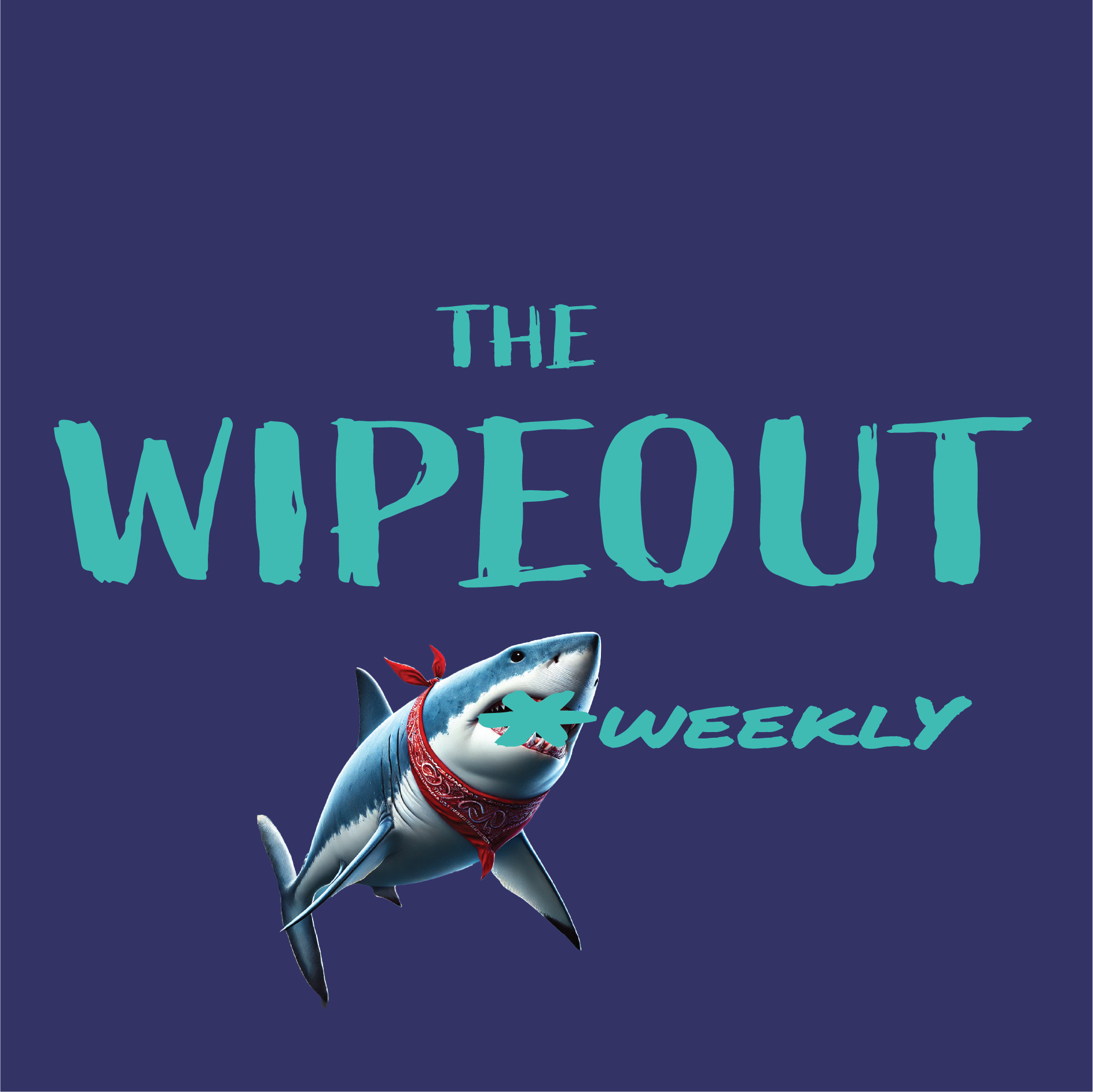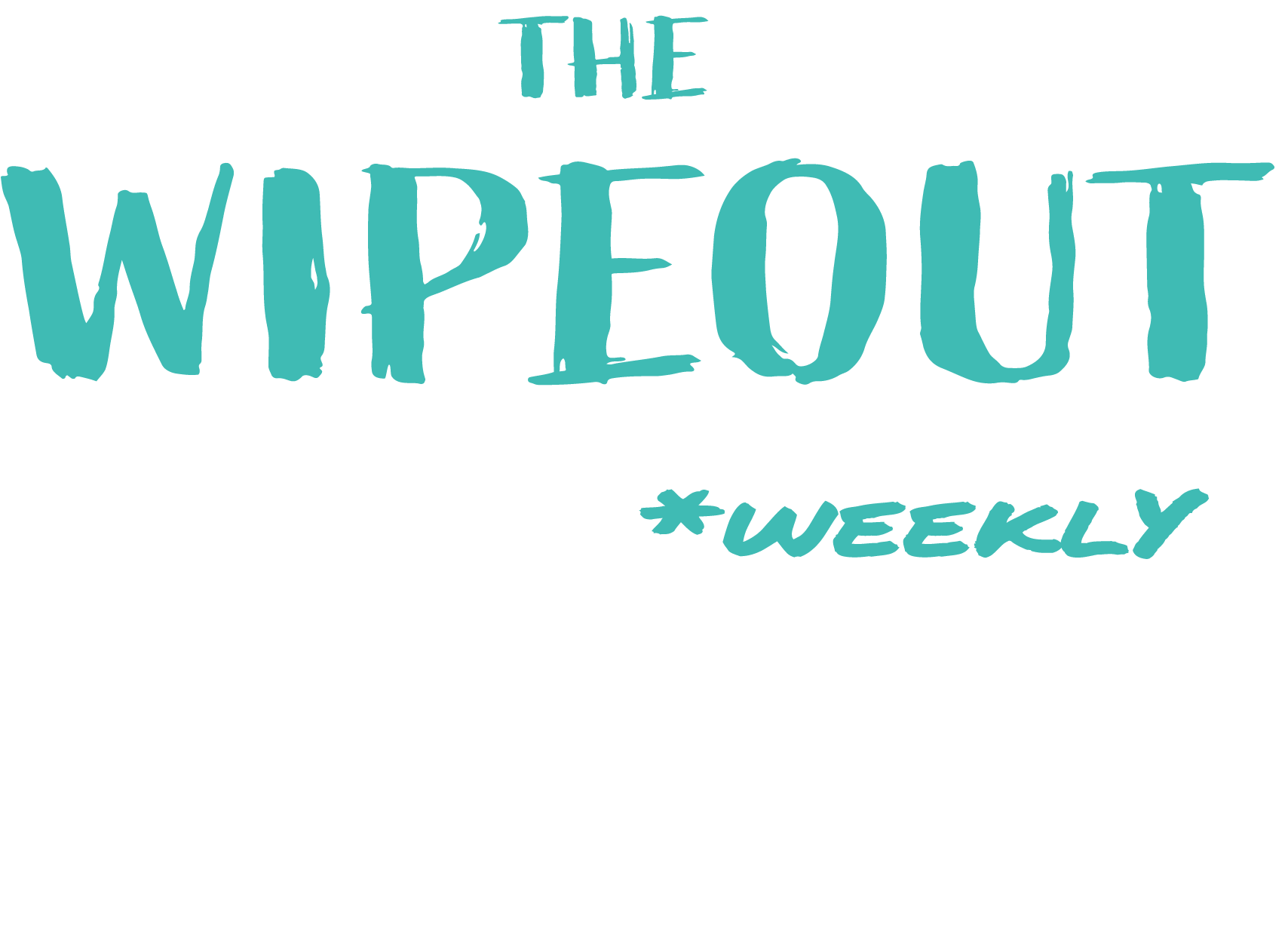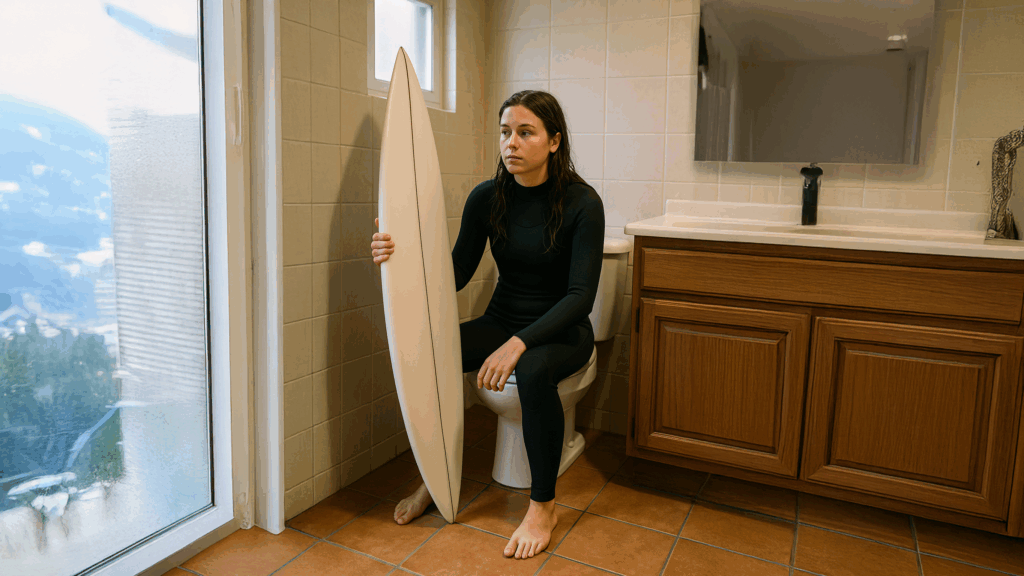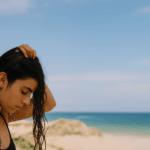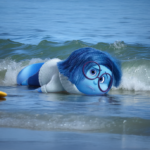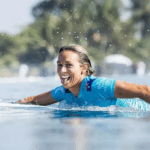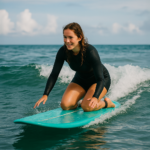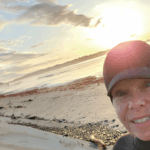Now Reading: “You, you!”—The magic of a surf buddy with Tina Heaney
-
01
“You, you!”—The magic of a surf buddy with Tina Heaney
“You, you!”—The magic of a surf buddy with Tina Heaney
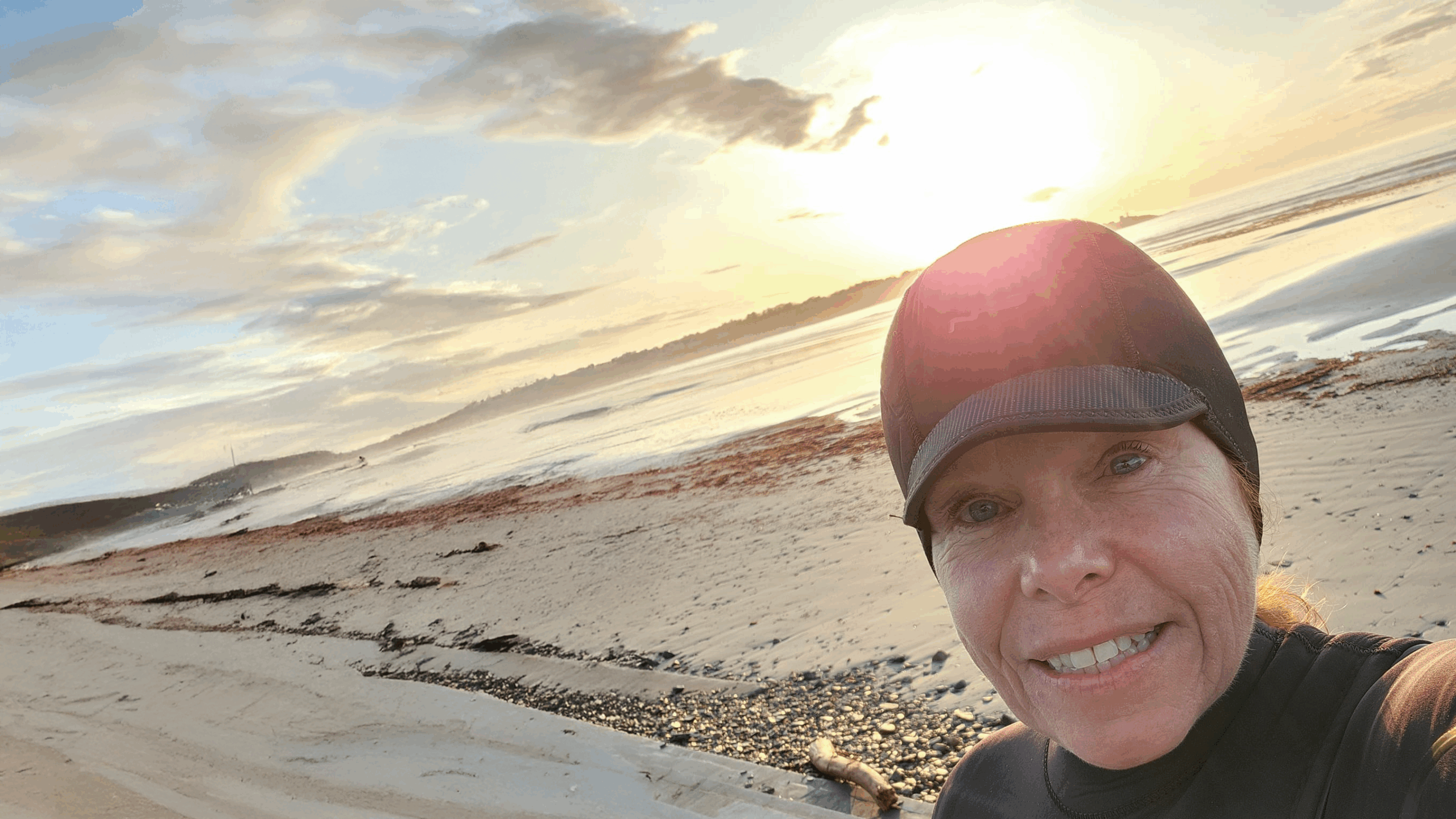
This Wipeout Weekly podcast episode transcript was abbreviated to a blog post format by my good friend Chad (ChatGPT). He takes liberties, you know. You will find the full transcript below it. Host: Zuz Wilson | Guest: Tina Heaney
Zuz:
You’re a bit of a legend among Girls Who Can’t Surf Good now, because you’re the surf buddy that everybody wants to have—especially after we shared your story with Lauren. So, tell me how that all came about.
Tina:
I’m a beginner. This is only going to be my second full season. I moved to the coast of Maine last May with my boyfriend, and aside from him—he’s an awesome surf buddy—I didn’t really have any female friends. He travels a lot, so I was looking for someone to surf with.
I posted in the Girls Who Can’t Surf Good group, met up with a few women, but most didn’t work out. One didn’t get in the water, another just wanted to talk while there were waves, and another disappeared after one session. It was hard.
Then Lauren and I met. She lives an hour away and I’m only half a mile from the beach, but she showed up ready to go. We hit it off immediately—it felt like I’d known her forever. We just clicked.
Zuz:
That’s so lovely. And you’ve been surfing together since?
Tina:
Yeah, we were actually out this morning. She rides a foamy, and I recently got my first brand-new board—my second hard top. I let her use my first board, an 8’6”, and I watched her catch wave after wave while I was getting nothing. I was so stoked for her. It was super foggy, the waves were getting bigger, and I couldn’t even see the beach, but I kept looking back and seeing her ride wave after wave. It was great.
Zuz:
I love that story. But wait—reading Lauren’s post, I assumed you were a super experienced surfer!
Tina:
Not at all! I come from a sports background. I was a ski racer, ice climber, hiker—those kinds of things. I can snowboard, but I’m a better skier. Surfing is the hardest, most frustrating, and most rewarding sport I’ve ever done. I got hooked quickly, even though I didn’t realize it at first—my boyfriend said he could see it in my face the first time I got worked trying to paddle out.
Zuz:
When was your first surf?
Tina:
It was two years ago, late May. My boyfriend took me out on this heavy wooden 9’8″ board he calls Gretchen. He pushed me into tiny waves and I just wanted more. Every step, I wanted more.
Zuz:
Did popping up come naturally?
Tina:
No, definitely not. My pop-up was all wrong at first. I was in this tight ski-racing tuck—compact and facing forward. We were on a video call one day doing yoga, and he saw it and was like, “Yeah, that’s your ski background.” We worked on it from there. I’ve done a lot of dryland drills, and I watch a lot of surf videos. I learn a lot visually.
Zuz:
What land exercises helped the most?
Tina:
Push-ups. Downward dog to cobra. Hip openers so I can drive that front foot through. I’ve been working on compressing more, keeping things tight. I’ve learned that weight shifting is critical—otherwise, I nosedive.
Zuz:
Have you ever been filmed to analyze your pop-up?
Tina:
Nope! Never taken a lesson or been to surf camp. I just surf.
Zuz:
That’s amazing. I’m working on a piece about whether you need lessons to progress. So many people used to just learn with a friend or on their own, but now it feels like there’s pressure to get coaching.
Tina:
I think lessons would be great—I just haven’t done one. It’s expensive, and I usually just do research online or ask people in the group. When I went to Baja recently, I learned what real Pacific surf is. Heavier waves, fast jackups. Cerritos was a shortboard wave. I’m a longboarder, and it was tough—but I adapted.
Zuz:
How was switching from East Coast mushy waves to Mexico reef breaks?
Tina:
Totally different. In Mexico, a three-foot wave in the report turns into an overhead wall when it jacks up. I remember riding down the line and seeing the wall next to me—I thought, “Don’t you dare screw this up.” I could’ve reached out and touched it. It was the coolest thing ever.
Zuz:
You surf through winters in Maine. What wetsuit do you wear?
Tina:
A 6/4/3 hooded suit, liquid-taped. Seven mil booties with wool socks, five mil lobster claw mittens. In the shoulder season, I wear a 4/3 with a hood and six mil boots. The water’s in the low 40s Fahrenheit. It’s heavy, and your hands get tired, but you build strength.
Zuz:
Do you prefer warm or cold-water surfing?
Tina:
Less wetsuit, for sure! It’s just more fun and less tiring.
Zuz:
How often do you surf?
Tina:
In summer, I’ll surf 5–6 days a week. Last year I surfed 21 days in a row. In winter, maybe once a week or every other week depending on the conditions. The more I surf, the faster I progress.
Zuz:
What’s been the hardest thing to learn?
Tina:
Popping up consistently. Trusting it. Knowing I can do it even when the waves are steep. And learning that the ocean reflects whatever you bring into it. It’s a mirror. If I’m frustrated or impatient, the ocean will show me that.
Zuz:
Have you ever thought “This is too much, I’m done”?
Tina:
No. Never. I’ve been scared, sure—but I always want to go back. I got smacked across the face, sliced by a fin in Mexico. But I’m not stopping.
Zuz:
Do you have any parting wisdom for new surfers?
Tina:
Just get out there. Don’t wait. You don’t need fancy gear. It’s a commitment, yeah, but it’s worth it. I’ve got a closet full of wetsuits now. And yes, a surf buddy helps—someone to share the stoke with. Lauren catching a wave while I point and yell, “YOU!”—that’s everything.
Zuz:
Thank you for sharing all of this, Tina. That was beautiful.
Tina:
Thanks, Zuz. I love being part of this community.
Full transcript
(0:00 – 2:29)
Having a surf buddy is, it’s wonderful because you can share your ups, you can share your downs, you’re out there in the surf, you’re catching up with each other’s lives and, and working through whatever’s going on elsewhere. You share the stoke. Welcome to the Wipeout Weekly, the daily podcast for beginners, wannabe surfers, and seasoned wipeout enthusiasts.
No hype, no filler, just the highs, lows, and honest truth about learning to surf and finding your place in surf culture. I’m your host, Suze Wilson. Let’s go out.
You are a bit of a legend among girls who can’t surf good now because you’re the surf buddy that everybody wants to have. Following our story about your, your encounter with Lauren and, and your friendship. So just tell me a little bit more from your perspective, how this came about.
So I moved, I’m, I’m a new surfer. I’m a beginner. This is going to be my second full season.
Um, and I moved, I moved to the coast of Maine last May. Um, and my boyfriend and I moved in together and, um, I didn’t have like, aside from him, he’s like an awesome surf buddy. I’m super stoked.
He travels a lot though. And I didn’t have any female friends and on the girls who can’t surf good Facebook page, I, um, had interacted with a few women and met up with a few, um, only really got in the water with one of them and never heard from her again, met up with someone else who literally we spent a half an hour talking and she just wanted to continue talking. I’m like, wait, wait, wait, there are waves.
This is what I’m here for. So I want to get in. And then someone else who told me she was a surfer and she didn’t even get out into the white water.
Um, so that was really hard. Um, and then, yeah, I, I was like, yeah, I’ll meet you. Sure.
Let’s meet. That’s who I am. So you were actually also looking for a surf buddy.
(2:30 – 5:38)
Yes, I was. And Lauren was your like X try to find one. Exactly.
Yeah. And then, and then, um, we met at the beach one morning. She lives like an hour away.
I, I literally live, I live less than a half mile from the closest beach. I live two and a half miles to the bath house of where we surf. So it’s super close.
Um, she arrived and was ready to go wanting to get into the water. She was excited to be there to surf. And, um, we parted ways that day.
And I, it was just like, I felt like I’d known her forever. We just clicked and, um, yeah, we were just like instant buds, which was awesome. Um, yeah.
And actually we were out this morning. Yeah. And, uh, she surfs a foamy and I have been getting her, I recently bought my first brand new board, uh, my second board to me, my second hard top.
And, um, so I am letting her use my first, which is an eight, six and yeah, I watched her catch loads of waves and stand up a lot. And, um, it was awesome because it was so foggy. I couldn’t see, like I paddled out and I couldn’t see the beach at all.
Everything was disorganized. The waves were getting like getting bigger and bigger. The longer I was out there, I was like, yeah, they were like five feet now and I can’t see anything.
And I would look back and I would see Lauren catching wave after wave as I was like catching nothing. Um, I caught a few good ones that I was so stoked for her. It was great.
Um, yeah, I’m, I’m truly honored to be her friend. I love the story of your friendship so much, but listen, you, you said that you only got into, into surfing quite recently because reading Lauren’s, um, story, I completely assumed that you were an experienced surfer. No, not at all.
Um, I have a sports background. I was a ski racer. I, um, ice climber, hiker, like all the things.
Um, and I can snowboard. I’m not great at it. Um, I’m a much better skier.
Um, and I raced competitively for a long time. There were a lot of crossover elements into surfing. However, surfing is the hardest, most frustrating and most rewarding sport I have ever done.
Um, and I think you either get hooked or you’re done with it. And I got, I didn’t realize how quickly I got hooked. My boyfriend was like, yeah, the first time you like got worked trying to paddle out and I could see the determination on your face.
And he just knew, um, that I was hooked. I didn’t even know. Um, yeah.
(5:38 – 6:19)
So I started, I got my first hardboard. It’ll be two years in September. Um, prior to moving to Maine last May, I lived in New Hampshire.
I lived up on a lake and the summer before I would travel down here, it’s like a long hour drive. Um, but he gave me all sorts of homework to do, like getting out on my foamy and paddling across the lake, which I would do, um, back and forth every day. And then he gave me like paddle, um, sit and spin and paddle like I was catching a wave drills, which I did.
(6:19 – 7:09)
I did everything he said, because I want to be good. I just want to be good at it. So when was the first time you surfed? Do you remember the first time you went into the ocean and you surfed and whether you popped up or you didn’t? Yes.
He, um, took me out. It was the end of May, two years ago. Um, he took me out on a nine.
Oh, it’s a nine six. Um, no, it’s a nine eight. He has this really heavy board.
It’s all wooden and it’s beautiful. Um, he calls it Gretchen. Um, yeah.
And he pushed me on to like little tiny baby waves and I wanted more and every step along the way. I just want more. I caught a green wave.
(7:09 – 11:34)
I just wanted more like all of it, all of it. Yeah. And yeah, it’s just so fun.
I just want more. Did popping up come to you naturally? Cause that’s like the most frustrating thing for me. Um, it’s the hard it’s hard.
It’s getting better. It’s getting more smooth. I, um, tend to do a lot of dry land pop-up drills.
Um, and it’s changing. My pop-up is changing. So coming from a race background, my pop-up was to basically be straightforward, everything in alignment, like basically in a tuck.
And so he and I were like, um, basically like zooming. We were on a video call together, um, doing yoga and exercises and stuff. And he was like, all right, let’s see your pop-up.
And he saw it and he was like, oh, I see exactly what I see exactly your background. Cause I was crouched all low. Everything was super compact, but I was facing straightforward.
So we worked on it from there. No, it didn’t come naturally at all. I watch a lot of, I learn a lot by watching.
So I watch a lot of videos, um, to teach myself. And then I watch people in the ocean all the time. Yeah, I do the same.
I watch a lot of YouTube videos. Which of the land exercises you feel were the most helpful? Push-ups are hugely helpful. Um, going from like downward dog to Cobra and then, you know, doing a pop-up really and, and working initially to put that back, place the back foot and then, um, putting my front foot forward.
So there’s a lot of like, um, I forgot what it’s called a lot of hip exercises and hip openers. Um, so I can drive that front foot between my legs, between my arms, um, to do that. And now it’s a lot lower rather than just like popping up and having just a lot of space in my body.
Everything is more compact, which as I’m learning, I’m realizing that in my pop-up as I’m popping up, my weight needs to shift backward. Um, there’s a lot of weight shifting that goes on because otherwise I’m just going to bury the nose and, and body surf in dragging my board behind me. And that’s not that much fun.
I mean, it’s fun. It’s not my intention though. Did you ever get yourself filmed while surfing and doing a pop-up so you can just do some analysis? Never.
I have never taken a lesson. I’ve never been to surf camp. I just surf.
You know, that’s great that you’ve just said that because I’m working on a piece, uh, about do you need lessons? Because in the, I want to say the, in the olden times, even in the few decades ago, um, you would just have a friend who knew how to surf and you would go out with that friend once or twice. And then if you, as you said, you got hooked, you would continue going out on your own or with your mates and you would just sort of learn naturally. But now it seems like there is this big push as to like, you have to take a lesson.
And then if you want to progress, you should be working with a coach. And I understand that there’s a lot of advantages, obviously, um, of that approach, but I wonder how you feel about it. Oh, I think it would be great.
I just haven’t done it. Um, and I think about, you know, the expense of going to surf camp rather than just going somewhere and asking. And, and I do a lot of research online and, um, Surfline is great for beta as well, depending on where you’re looking to go.
Um, and then asking questions in the group. It’s been great. I mean, I went to Mexico.
I went to Baja, um, recently and I learned that I learned what Pacific ocean surface is. You guys have heavy waves. We do.
Way heavier than I’m used to. Um, and then, so we went to Cerritos and the waves jack up super fast and they’re, they’re really a shortboard wave. I’m a longboarder.
(11:34 – 11:54)
Um, so we went down to the, to the end of the peninsula where the, it was just different, um, and reef, which I’m not used to at all. So that terrified me and, um, I got cut up a little bit, but that’s okay too. So in Maine, where you surf, is that a beach break? It’s all beach break.
(11:55 – 15:03)
And this is like slow rolling waves. Yeah, we don’t, our beach is really shallow as opposed to like New Jersey or, uh, Virginia where the beach rises super fast. So those waves come in and then they jack up and dump.
Our waves, they’re mushy. Um, and they go for, well, I don’t know. It feels like sometimes, sometimes there are long rides.
Um, if you can ride down the line, um, just depends on the day, but they are mushy. There’s never, we rarely get barrels and it would be a beach, like a half, half a mile, a mile away that sometimes does. And it just, and yet it’s a shortboard wave because it jacks up into an A-frame and you’ve got to be at the apex of the frame and you’re down and that’s pretty much it there.
How did you find that switch from going from East Coast waves to then going to Mexico? Was that difficult? At Cerritos? Yes. At the base, at the bottom of the peninsula, not so much. What I wasn’t used to is because it’s reef.
So if the report said it was three feet, that was before the wave stood up. Um, so we were out surfing one day and I was on a wave and as I was riding down the line, I could see the wall of water just jacking up right alongside of me. And all I could think of is don’t you dare die.
Don’t you dare, don’t, don’t F this up. And it was, it was, I’m five two, it was above my head and I could see it just like right past behind my head starting to crumble over. It was the coolest thing I could have, had I thought about it, I’d have reached out and touched it.
I could have. It was right there and so close. It was the coolest thing ever.
And as I’m surfing more and more and you know, I still suck. Um, I just suck maybe a little bit less depends on the day. Um, I’m having more of those like aha and click moments because it feels like a click, which is super cool.
When you surf in Maine and I know that you surf through, through winters, you wear a suit. What is it? Five, four, six, six, four, three hooded, all liquid taped. I wear a wool shirt underneath, seven mil booties, wool socks, five mil lobster claw mitts.
I remember those from my time in the UK. I do have a pair. Yeah, you would have too.
Cause I have cold water. Yeah. Um, so I’m in my, I’m in my colder of my two shoulder season suits, which are four threes.
This one has a hood and integrated hood still in the globster club mittens. I’m in six mil split toe booties, no socks, but it was foggy today. So I did wear a wool shirt underneath it.
(15:04 – 15:59)
Um, yeah, if it’s sunny, I’ll get hot right now, but our water temperature, it last at the beginning of last week, I think it was 43. It’s 47 Fahrenheit. I’m trying to think what’s the coldest temperature I ever surfed in.
It was four Celsius, whatever that is in Fahrenheit. Okay. So it’s probably like 38 ish, which is our winter, which is about our winter temperatures.
I don’t remember wearing any socks. I didn’t even know socks existed. It was just booties.
Oh yeah. I just wear like, like smart wool socks underneath. Oh, so these are regular socks.
Yeah. Not surf socks. So I don’t care if they get wet and in a, in a suit that’s that thick, um, you don’t tend to get really, you don’t get flushed much.
(16:00 – 16:19)
So everything tends to stay fairly dry underneath unless you pee a lot. I used to save up my pee when, uh, when I was, uh, surfing in the UK during the winter, because like, oh, I’m gonna, I’m gonna warm myself up now. It was a great feeling.
(16:20 – 18:33)
That’s exactly what it is. I’m like, oh my gosh, I’m finally warm again. Do you feel that the wetsuit and everything else that you’re wearing is constricting your movement? Because now you’ve got that, um, comparison to Cerritos, where you probably didn’t even wear a wetsuit or a spring suit or… I was in a three, two in Mexico.
The water was about 70. Um, one afternoon I didn’t wear a suit. It was the first time ever.
I just had a rash guard on and I should have waxed my board a whole lot. I didn’t realize how much a wetsuit helps you stick to your board. Um, the winter suit is heavier.
You get tired a lot faster. Um, and having the mittens on, your hands get tired. Like you, because you’re pushing so much more water with it and water has a, water has a great deal of resistance.
Um, so your hands get strong, you get strong pretty quickly. Which type of surfing do you prefer, more wetsuit or less wetsuit? Less wetsuit, of course. And no gloves and no booties and no hood is so nice.
And we’ll be, we’ll be down to that, uh, next month. So yeah, so when you’re surfing in the summer, this is just like the regular three, two or is it four, three? Regular three, two are water temperatures typically in the summer about 68. It’ll get to be 70, maybe 72 for a few days.
Does it get busier in the summer? Do you have like a lot of people just coming out and trying surfing where you surf? Um, the beach gets busy. Um, and there are swim buoys. They’re both gone from storms.
Um, you can see the rope underneath the water, which is kind of interesting. Um, so before 8 AM you can surf anywhere on the beach or after five o’clock anywhere on the beach. Otherwise we have to be outside of the swim buoys.
(18:34 – 18:48)
Um, but there’s places, there are places and you can swim anywhere. Yeah. And, um, it was super unnerving that people would just be swimming right where you’re trying to surf.
(18:48 – 22:08)
And I had no idea how to turn and people, as you’re coming straight at them and the look of fear on their face, you figure it out. You like, you always will turn around them. You’re never going to hit them because instinctively you actually, your body knows what to do.
Um, but that, yeah, that’s a little, that’s super unnerving, less unnerving now, but it’s never super, it’s not like, it’s not like surfing in California or Florida or anything that, or, or like some of the crazy videos that I’ve seen, um, where there’s the beach will be fairly full. Maybe there’ll be like 40, 50 people. The beach, um, is like two parts.
There’s north of the restaurant and they’re south of the restaurant. So north of the restaurant, um, at sunrise at like four 30 in the morning, five in the morning, there might be 30 or 40 people that’s in a mile. That’s a whole mile length.
And within that mile are all sorts of different breaks, um, depending on the, on the, on the direction of the swell on the direction of the wind on all sorts of things. It’s never crowded like that. And people it’s, it’s a really warm and welcoming vibe here, which is really great.
Like as a, as a woman, I’m never worried about being out in the water with all guys ever, which is really cool. But you start super early. What time do you go out? In the middle of the summer, we’re up making coffee at four.
We’re in the van before four 30. Yeah. We’re out by seven, which is great.
Cause then you can work a full day. Yeah. Yeah.
Then yeah. We’re, we’re in bed early. Wow.
4 a.m. Start. It’s light out at four here. It’s light out until after nine at night.
So maybe we’ll start in the evening. We’ll start surfing at like six or seven and then be done by eight, eight 30. Maybe we eat dinner, like snack dinner at the beach.
Maybe we come home and hopefully there are leftovers because we’re just exhausted. In the summer or even in winter, how often do you surf during the week? In the summer, it’s easier because there are longer daylight hours. So if there are waves, if there’s anything from like, I don’t know, 1.8 and bigger.
So I might surf like five, six days a week there. Actually, last summer I surfed 21 days in a row. I was exhausted.
Amazing. Yeah, it was great. And then winter’s supposed to be better surf.
We just had so much westerly wind that it knocked the waves down. So we might surf once a week, once every other week. It’s getting better now that the weather’s turned.
Do you feel you’ve progressed more when you were surfing more or do you think it didn’t really make any difference because you were doing all those sort of land exercises in between? I find I progress faster the more often I surf. Yeah. Because there’s just, there’s so many subtleties and so many nuances that you’re not going to get unless you’re actually on a wave.
(22:08 – 22:42)
Like the other day, the last, what day is today? Wednesday? Yeah. So Saturday and Sunday, the waves were small, like two, three feet, not a lot of energy in them. And so I was able to really work on placing my weight really on my back foot and taking and smearing that front foot to go more down the line and to actually turn or when I’m popping up, like turning as I’m popping up.
(22:43 – 26:45)
Just, yeah, learning new skills. Do you give yourself goals, surf goals? This is what I’m going to do this week or this is what I’m going to achieve this month? No, because I don’t actually know what’s next until it just happens. And I was like, oh, that’s really cool.
I want to do that again. Yeah. I think my goals initially were like consistently catching waves.
So not this past Christmas, the Christmas before Christmas Day. Yeah, I caught like 15 waves. I was thrilled with that.
So that was the first thing and then catching them and popping up on them, whether I can stay on board or not is another thing. And then I broke my right ankle. I broke my talus.
I had an ice climbing accident. So I didn’t walk for six months. This was a while ago.
So my back, I’m regular. So my right foot, my back foot doesn’t have the mobility. So there’s a challenge and I’ve just and I figure it out to make it work.
So from everything that you have done so far in terms of like progressing and surfing, what was the hardest thing to learn? Popping up consistently. That is the hardest thing. And trusting it, like trusting it.
I was reading, I read Lauren’s, Lauren’s story, which is fabulous. She’s a really good writer. And yeah, sometimes the waves come in and they’re really steep and that drop is scary.
I sometimes, I, you know, I have one time just had a guy say, it’s just water. I say that to her too. I’m like, it’s just water.
And, and yeah, I’ve like, I’ve gotten smacked in the head. I got, I got smacked across by the rail across my face. I, I actually took a fin across my quad in Mexico.
Luckily I had a wetsuit on or I’d have been home because I’d have gashed my leg wide open. But none of it is, none of it is fatal. And I’m not going to let it stop me.
Do you have any insider tips or tricks that you use when you, when you get scared in the ocean? Like you said, Oh, it’s just, it’s just water, right? Anything else when you’re staring down, looking from the top of that drop? Um, sometimes I just take the drop. Sometimes I’ll take it on my knees if it’s really steep. Sometimes I back off.
Um, I have to be, it’s, it’s about being in the right head space. Sometimes I get all excited and I know it because our beach is really wide at low tide, maybe, uh, maybe like an eighth of a mile wide walk down into, to the water’s edge. Um, but I can feel my heart racing.
I feel like my breath getting short and I just have to remind myself to slow down, um, and, and just get calm and get out in the water. Like this morning, because we couldn’t see the waves. Um, I had Lauren come way out with me past the break and, um, I was just like, I want to be out too far so I can watch and see what the waves are doing because I can’t see them from the shore.
Um, yeah, it’s about being in the right head space. So sometimes I’m out there and things are not always the best. I always, I give gratitude and I just sit and calm myself down and get myself into a better head space.
Um, there are times that I’ve been out typically hurricane swell. Um, and I can get out and then I’m like, Oh shit, I’ve got to get back in. I’m not really sure how I’m going to do that.
(26:46 – 27:50)
Um, I don’t have to take the biggest waves and I’m okay with that. I beat myself up a whole lot less than I did when I was starting. I’ve learned to grant myself grace and know that not every day is going to be exactly what I want it to be.
Um, I also know that whatever I bring into the ocean, the ocean’s going to reflect right back at me. Um, it’s a huge learning tool that apparently I need. Um, the same lessons keep showing up in my life and the ocean is an amazing magnifier of my impatience in life.
You’re looking at the surfers in the ocean, it’s like, Oh, you know, I should be able to do this. This cannot be that difficult. And I personally get extremely frustrated because you just, you just want to get better and you want to do it faster.
But at the same time, as you said, it requires being in the ocean and surfing. And sometimes I forget about it and I just, uh, Oh, I’ll go next week. The waves are not looking good enough right now.
(27:52 – 28:59)
I think we all do that. Did it ever scare you? You know, all the injuries that you were talking about and things that happened that you get smacked in the face. Did it ever feel like, Oh God, no, this is stupid.
I don’t want to do this anymore. No, that’s not a good thing either. I, I had, I was like a brand new server, like brand spanking new.
And we were in Rhode Island for a boat show. And, um, it was a hurricane, it was pre hurricane swell. And my guy went out and it’s the only time he has ever said to me, like, be careful, don’t die.
I had no idea what he was talking about. The white water was more than four feet thick. And I just kept trying to get out and get out and get out and get out until I just couldn’t anymore.
(28:59 – 29:27)
And then I was like, okay, I’m just going to play in the white water. I’m not going to let it beat me. I was so incredibly frustrated.
And then I watched him catch. It was an amazing ride. And it was long.
He’s six foot. And he was a third of the way up on the face of the wave. And it was still overhead for him.
And then I realized like how big that surf was. I was never going to get out. And I was never going to get back in had I gotten out.
(29:28 – 30:00)
Do you know what’s the biggest wave you’ve ever surfed? Yeah, I’ve been on an overhead high for me. So it was probably six foot by the time it stood up. That was in Mexico.
I’ve been here on five foot waves. They’re not my favorite because they are scary. They’re big and scary once they stand up.
I like three to four, four foot waves, three foot waves, two foot waves are fun. Yeah. Half a foot wave is a lot of fun for me.
(30:00 – 30:27)
There you go. Exactly. Yeah.
Or I’m like, yeah, two foot waves with like 38 per kilojoules of energy is awesome. You know, I haven’t even started checking wave energy until quite recently on Surfline. And now I am obsessed with it because I’m looking at it’s like, oh, there’s no way I am going out.
(30:27 – 30:36)
It’s like 200 kg. It’s like I’m not going to get out there. How much time do you spend studying the forecast? More time than I ought to.
(30:38 – 32:04)
I probably look at the forecast five or six times a day. I’m totally obsessed. And it changes.
It changes throughout the day, too. But yeah, I’ll be like, yeah, I don’t want to really go. When I started and they started putting the energy in Surfline, I was like, anytime that number’s over eight, that’s awesome.
And now I’m like 16. I don’t want to go out. 24.
That’s not any good. And I just have to like ignore it. We were out fairly recently and they were like three and a half foot waves.
But the energy was like under four. There wasn’t enough energy for the wave to pick you up and carry you. So it was hard unless you were just you had to be at the very peak.
And that’s yeah, being at the very peak is hard. It’s scary. With Surfline forecasts, what tended to happen was here in L.A. and I’m pretty sure it’s everywhere else, they were always underreported.
I’m a realtor. I produce a daily like New England surf report that goes up on my website and it’s on my Facebook page and my Instagram page and stuff. Yeah.
And it’s in conjunction with Surfline. And I before we publish it, I reached out to them to make sure they were OK with that. And I remember and they were, which is great.
(32:05 – 32:39)
But when, yeah, I would say like two to three on the way left hand side and then it was like 4.5. And I was like, I contacted them like, what is the discrepancy? Well, this is the algorithm. And the other one is actually observed. And we have a bunch of buoys here.
So that’s easy for them to get the data from. Yeah, I look at both of those things because I know that one is really just an algorithm more than anything. And I try not to obsess too much over the wave height.
(32:40 – 32:56)
Like this morning, I probably would have been happier with three foot waves. But I was like, yeah, four, four and a half, 4.7. I can’t see anything. So maybe that made it easier to go out.
(32:57 – 34:10)
You cannot see how high that wave is. No problem. Exactly.
Poor Lauren was like, I couldn’t see you out there. And we had drifted. The current was dragging us north and we couldn’t even see.
And all of a sudden, like in the off in the fog distance, I saw the bathhouse. I was like, dude, we’ve just we’ve just like drifted a half mile. And she was like, all right, well, I’ll walk back.
And I was like, I’m going to paddle out and I’m going to paddle back and then I’ll catch one in and then I’m going to go for a run. And the poor thing, like she’s like, like in the white water, kind of walking back and walking south. And the waves had gotten bigger.
So I had to paddle way farther out. And she was like, I couldn’t see you. I was getting worried.
And I was like, I couldn’t see the land. I kind of got a little worried. And I was like, I’m not going to worry about this.
I know kind of where I am. I’ll figure it out. She’s like, no, I really got nervous.
I couldn’t see you anywhere. I don’t think I could surf without seeing where I am. I think I would be too scared.
(34:11 – 37:23)
Are there any places in the world where you would like to surf? I would like to go to Nicaragua this over Christmas this year. I’d like to go everywhere. The dream is to live on a sailboat for four or five months a year and to sail to different surf places.
Oh, it sounds like a perfect dream. Yeah, that is really the end goal. I’ve got two cats.
I don’t think they would appreciate me being on the sailboat with them for three to four months. I’ve seen cats on sailboats. Oh, they’re very spoiled cats.
So no, they would not have that. Oh, fair enough. Yeah.
So that is a problem. Tell me about your quiver, because you’ve mentioned that you’ve got two hardboards now. I have two hardboards.
I have a foamy and I did those drills and I did the homework enough that I actually wore the top plastic sheet off of it. It’s kind of crazy, right? Yeah, I guess I like to exercise. So my first hardboard, I found it on Facebook Marketplace.
I traveled down to Gloucester Mass. It was a few hours. It’s like two and a half hours.
It was an 8’6″. It is an 8’6″. It’s not a destroyed board.
It’s an 8’6″, squash tail. I think it’s 22 and three quarter, 21 and three quarter. All my boards I have to carry on my head because I’m so short.
And I want to see, would it be three inches in volume? I’m not exactly sure. I love it. It was great.
I bought it from this guy. He had it on his wall because he had had an injury and he couldn’t surf anymore. And he had it custom made for him by a local shaper.
And there were just a few little heel strike marks. Now it looks like ping pong ball. It looks like it’s been out in a hailstorm from so many heel strikes.
It was an awesome board to move up. My foamy was an eight foot that I bought off of Facebook Marketplace for $200. My first hardboard, I think I paid six for it and he gave me a leash as well, which was awesome.
And yeah, Lauren is riding that now mostly. I’ll take it out on bigger days. So my second board, I found it on Facebook Marketplace and it’s brand spanking new.
It’s a 9’2″. It’s a nose rider. I do not know how to do that.
(37:24 – 37:39)
That is a goal. That is my goal. I want Lauren to bust up and hang five, 10 eventually.
I need to get into the cross step part first. It’s a nose rider. It’s really light.
(37:39 – 37:47)
It is less of a squash tail. He called it a shaka style. I don’t really know what that means.
(37:47 – 37:55)
Neither do I. And I love it. I absolutely love it. It’s such a fun, fun, fun board to ride.
(37:55 – 38:39)
Um, so like catching waves is actually easier on it. You can’t put your head down too much or else you’ll bury the nose because of the big, there’s like a big dish out on the nose underneath. So you can nose ride it.
Um, so which just means I’m playing more with weight shifting and stuff, uh, to make it work. Um, yeah. So my new board is called Goose.
My other board, cause the guy who made it is, he calls himself the Sly Mountain Goose. So we call it Goose. And my first board, um, it was shaped for the guy whose name was James.
So we call it Jim. Oh, that’s so nice. I don’t think I’ve named my boards.
(38:40 – 39:52)
What do you have? I’ve got nine, six. I love it so much. The only problem is that Venice breakwater where I surf, it’s more of a shoreboarding break.
So, um, it has to be really one to two, uh, for me to take the long board out because then actually I will leave the whitewash and I will go a little bit further to the back. And then I would, um, I would have fun. Other than that, I’ve got, I’ve got a WaveStorm.
So eight feet WaveStorm. I’ve got a Jerry Lopez, which is also eight. I have a Magic Carpet, which is a super light board.
And basically the way they make it is they take a long board and they take two feet from the middle and then they kind of like push it together. That’s how they explained it to me. So it looks like a long board, but it’s a seven, seven, six.
Uh, and I bought a fish, a WaveStorm fish from Costco, like a couple of years back, but I have not even tried it. And I don’t think I could possibly even pop up on it. There’s no way.
(39:52 – 40:23)
Would you ever try a short board? Um, so my first summer I was, uh, I took out, I think it was a seven foot. Couldn’t be, it was about my height. So maybe it was like a six.
Um, I hated it. And I also wasn’t catching waves all the time either. Um, I really like the vibe of a long board.
(40:24 – 46:34)
I really like how I feel like I’m part of the ocean. I’m part of the wave. Um, I think that it’s more Zenful, um, than with a short board, you have to be turning all the time.
Um, yeah, I, I like the, the, I guess it would be like, it feels peaceful even though you’re turning a long board and stuff is just, it’s very different. It’s very graceful. So yeah, I can watch long boarding competitions for ages.
I have zero interest in watching short boarders. Right. Yeah.
And my guy has a nine eight, which he calls Gretchen. It’s heavy. Um, and it was made for like this woman.
I can’t even pronounce her last. It was a Polish last name. Oh, really? Yeah.
Yeah. Um, but she never wrote it. And, um, so we switched boards last week.
One day he was like, Hey, can I ride? Can I ride goose? Do you want to ride Gretchen? I’m like, sure. Um, so it was fun. It’s, it’s fun being at a stage where I can just hop on another board and ride it.
Um, so that was fun. Um, and then he gave his son a Canyon, which is a nine six Canyon, which is a pop out a Chinese. I think it’s a Chinese pop out.
Um, but I wanted to know if I wanted a longer board than an eight six. I thought I did. Um, so I wrote this nine six and I was like, yeah, I definitely want a longer board.
My nine, my nine two rides longer than the nine six does. Um, it’s just the type of board. Yeah.
I was just writing about volume and how important it is in, you know, when you’re choosing a surfboard. And one thing that I found was that depending on the shape of the board, volume works differently that a board that has got less volume may feel more voluminous. That’s the word.
Then the one with more volume, just because of the, how the foam is distributed across, across the board. And I, I found it very interesting, but it’s kind of like, you know, I know that for now I need something with 80 liters volume or like 70 something liters of volume because of my, of my weight. And also because I want to learn to pop up properly.
So I’m sticking with that. Mm-hmm. Yeah.
I don’t know how many liters of volume either of these boards have. Um, that’s okay. You want to find out just get a lot.
Yeah. Get a large paddling pool, pour water in it, put your board in it and then see how much water in liters it displaces. Oh, that’s how you do it.
Either it’s written on the board, like on the bottom of the board, along the stringer, or then you have to do this exercise where you actually have to measure the amount of water displaced. That’s gotta be difficult. Yeah.
Nobody does it. Obviously everybody’s like, okay, if it’s a secondhand board and I don’t know what the volume of it is, it either writes okay or it doesn’t. But yeah, this is another thing that I have, I have learned.
Is there anything that you have learned, um, from like watching YouTube videos or reading stuff along your surf journey that you found fascinating about surfing? The most fascinating thing about surfing to me is it is all the things. Okay. Okay.
It’s physical. It’s incredibly physical. I was, and I still am always surprised.
Like, I can’t believe my legs are tired. Well, of course, because I’ve been like egg beating them out there for two hours. Um, but it’s, it’s incredibly physical.
It is, um, it’s spiritual. It’s incredibly grounding. Um, it’s very cerebral.
Um, especially when I no longer talk myself through everything out loud as I’m doing it. Not all the time. Sometimes I do, if I’m, if I’m feeling a little intimidated or scared, sometimes I’ll be like, pop up, you know how to do this.
Come on. Um, it, um, I didn’t expect that it was going to be all the things and it really is more than anything else I’ve ever done. It kind of, it, it’s meditative.
You, the water, whether it’s, it’s surfing or scuba diving, the water is the only place where I find that I am come 100% present and you have to be, um, but everything else just goes by the wayside. Um, I don’t even notice the people on the beach. Um, and yeah, it’s a great way to start or end your day because it is all of the things and it, it’s hard to explain that to someone who a doesn’t serve or B does not, um, participate in sports or meditative activities or, or any of those things.
It, it, and it’s soft. It’s, it’s very feminine. It’s incredibly feminine.
Um, I think I find the water is really, yeah, it’s a feminine energy. Not even she could be mad sometimes. That’s okay too.
(46:37 – 47:41)
Mama ocean can be mad sometimes. Yeah. Do you ever get into a surf funk? Do you ever get frustrated? Because you don’t strike me as a person who would.
Do I get frustrated? Yeah. And the surf. Yeah.
Yeah. I get frustrated because I know what to do mentally. I know how to do it.
Um, making all the pieces come together sometimes is nearly impossible. Um, yeah, there are days that I’ve stomped out of the water and just been so upset and I do get laughed at my partner will laugh at me. And he’ll be like, I told you that you’re going to go home with your legs with your tail between your legs so many days.
And you didn’t believe me. Did you? I was like, no, because, and it’s like one of the things like you can’t force it. It’s practiced it’s rehearsed.
(47:41 – 49:36)
It’s of course, but you can’t make it happen. Like I will also try to will there to be white waves when there isn’t. And it just doesn’t work.
Is there anything that you would love people to know who want to get into surfing? Like one thing that wisdom that you would like to part? I think the most important thing is to just get out there and do it and embrace it and, and don’t be afraid. And if you don’t have a friend, and you’re not like, like incessantly watching videos when you should be working, um, and taking lessons is for a lot of people. And I’m not saying it isn’t for me.
I think it would be great for me. I just haven’t committed to doing it. Um, and it would be something I would do elsewhere, not here.
Um, because they, they tend to all the classes tend to be from what I see are for beginners. And there aren’t that many, there’s like one surf shop on our beach, um, to just do it and don’t be afraid. And it is a commitment.
It’s definitely a commitment. Like I thought like, oh yeah, I’ve got a wetsuit. Sheesh.
I have three summer wetsuits, two shoulder season, one winter. I have three pair of booties. I only have one pair of mittens, but cause, um, the place that I was ordering them from were out.
Um, I have two separate hoods that are detached, that are not attached. Like you think you’re like, oh yeah. Uh, yeah, it’s inexpensive.
(49:36 – 49:41)
They’re all expensive sports. They really are. What a wardrobe.
(49:47 – 51:00)
Would you recommend a surf buddy to everybody? I would say yes. Having a surf buddy is, it’s wonderful because you can share your ups. You can share your downs.
You’re out there in the surf, you’re catching up with each other’s lives and, and working through whatever’s going on elsewhere, um, helping each other out. Um, you share the stoke more than anything. Like I would look in and I would see Lauren catching a wave and standing up and she would look out toward me and I’d be there like pointing my finger at her, yelling you, you! Because that, that’s everything, right? It’s the stoke.
It’s the excitement. It’s the shared experience. Um, I don’t mind going out on my own.
I, there are so many times I’m in the water by myself. No one else is in the water. I don’t worry about that.
A lot of people do. So I would say for most people, yeah, having a surf, and even for me, having Lauren as my surf buddy is, is an enormous gift. And that’s all for today.
(51:01 – 51:10)
Check out The Wipeout Weekly for our free newsletter, more stories, and ways to connect with us. Thanks for listening. See you tomorrow for more of The Wipeout Weekly.
